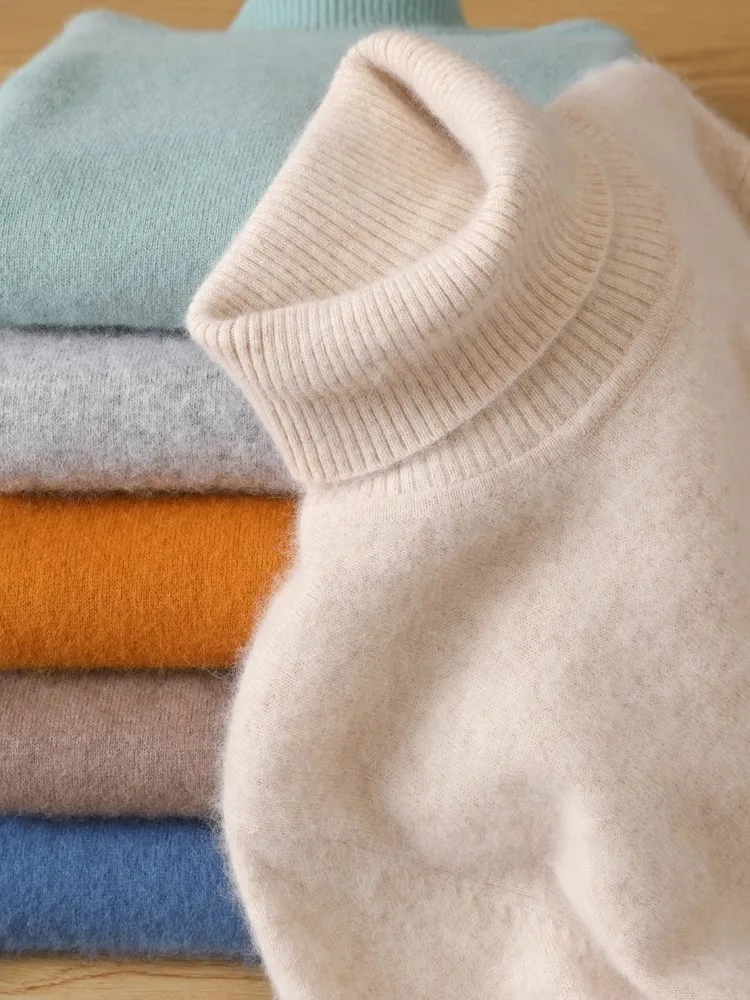Cashmere represents the pinnacle of luxury fabrics—a premium investment that deserves meticulous care to maintain its exceptional qualities. The incomparable softness, warmth, and elegant drape of high-quality cashmere can last for decades when properly preserved. However, without appropriate storage and care techniques, this remarkable fabric can quickly deteriorate, losing the very qualities that make it so desirable.
Properly preserved cashmere can remain beautiful and functional for 10+ years, while poorly stored items may become unwearable after just a few seasons. The difference lies not just in how you wear and clean your cashmere pieces, but critically in how you store them during periods of non-use. With premium cashmere garments representing a significant investment that can actually retain value over time, mastering proper preservation techniques becomes essential.
This comprehensive guide will walk you through every aspect of long-term cashmere preservation—from essential pre-storage preparation to advanced pest prevention strategies. Whether you’re storing seasonal items or preserving cherished pieces for years to come, these expert techniques will help ensure your cashmere remains in pristine condition. Understanding the fundamentals of proper cashmere storage forms the foundation for maintaining these luxury garments for years to come.
Essential Pre-Storage Preparation: Foundation for Longevity
Thorough preparation before storage is the most crucial step in preserving cashmere—one that prevents approximately 90% of common storage problems. This preparation process isn’t merely about cleanliness; it’s about creating the optimal conditions for fiber preservation during long periods of dormancy.
Properly prepared cashmere resists damage from moths, prevents permanent staining, and maintains its structural integrity even after months of storage. Professional storage services always emphasize meticulous preparation because they understand that the majority of long-term damage begins before the garment is even placed in storage. The comprehensive approaches to maintaining cashmere quality all start with proper preparation, which consists of three essential components: thorough cleaning, careful inspection, and necessary repairs.
The Golden Rule: Always Clean Before Storage
The single most important rule of cashmere preservation is never to store dirty garments. This principle is rooted in textile science—invisible residues like body oils, food particles, and perfumes not only attract destructive pests but also oxidize over time, creating permanent damage to the delicate fibers.
When cashmere harbors these residues, they serve as an invitation to moths and other pests that feed on protein-based fibers. Additionally, even invisible stains can become permanently set during long-term storage, sometimes creating yellowing or discoloration that becomes impossible to remove later. This is why proper cleaning before storage is non-negotiable.
For optimal pre-storage cleaning, you have two primary options:
Professional Dry Cleaning:
– Best for structured garments or heavily soiled items
– Ensures thorough removal of residues without handling the delicate fabric yourself
– Request minimal to no starch or sizing, as these can attract pests
– Use only reputable cleaners with experience handling luxury fibers
– Allow garments to fully air out after dry cleaning (24-48 hours) to eliminate chemical residues
Hand Washing (Preferred Method):
1. Fill a basin with lukewarm water (85-90°F/30-32°C)
2. Add a small amount of pH-neutral cashmere shampoo or gentle wool wash
3. Submerge the garment and gently agitate—never twist, wring or rub
4. Soak for 10-15 minutes
5. Drain and rinse thoroughly with clean water at the same temperature
6. Press (don’t wring) excess water out by placing the garment between clean towels
7. Lay flat to dry on a mesh rack away from direct heat or sunlight
8. Allow 24-48 hours for complete drying before storage
For special stains or challenging spots, specific techniques for addressing stains on cashmere should be applied before proceeding with general cleaning to ensure all residues are completely removed before storage.
Critical Inspection and Maintenance Before Storage
Once your cashmere is thoroughly cleaned, a detailed inspection becomes essential for identifying and addressing issues that could worsen during storage. This step prevents small problems from becoming significant damage over time.
Complete Inspection Checklist:
– Examine all seams for loose threads or separation
– Check for thin areas where the fabric is beginning to wear
– Look for small holes or snags that need repair
– Inspect for any remaining stains that didn’t come out during cleaning
– Identify pilling areas that need attention
De-pilling Process:
1. Lay the garment flat on a clean surface
2. Use a cashmere comb (preferred) or a high-quality fabric shaver (on lowest setting)
3. Work in one direction with gentle strokes
4. Focus on areas that typically pill first (underarms, sides, cuffs)
5. Remove pills frequently from your tool to maintain effectiveness
Addressing Minor Repairs:
– Secure loose threads with a few small stitches using matching thread
– Repair small holes immediately using matching yarn (or seek professional repair)
– Reinforce weakened areas before they develop into actual holes
This inspection and maintenance process is particularly important for valuable items like the premium cashmere sweaters that represent a significant investment. Taking the time to address minor issues before storage prevents them from becoming major problems that could compromise the garment’s wearability and value.
Optimal Storage Techniques for Long-Term Preservation
True preservation goes beyond simply putting cashmere away—it requires creating optimal conditions that actively protect the garments from degradation. Professional textile conservators rely on three fundamental pillars: proper positioning (folding vs. hanging), appropriate containers, and ideal environmental conditions.
When these three elements work together, they create a preservation system rather than mere storage. This distinction is critical because improper techniques can cause irreversible damage during long-term storage periods. Stretched necklines, permanent creases, yellowing, and moth damage are all consequences of neglecting these fundamental principles. Luxury retailers and museums implement these exact techniques when preserving valuable cashmere pieces for decades or even centuries, and the same principles apply to home storage. Understanding how to fold and store cashmere safely creates the foundation for all other preservation techniques.
Fold, Don’t Hang: Preserving Shape and Structure
The structure of cashmere fibers makes them particularly susceptible to gravity’s effects over time. When hung, even on padded hangers, cashmere stretches gradually, causing distortion in the shoulders, neckline, and overall silhouette. This damage becomes permanent after extended periods.
Scientific Explanation: Cashmere fibers have natural elasticity but limited recovery capacity when stretched for long periods. Hanging creates constant tension on the fiber structure, especially at pressure points where the hanger contacts the garment. Over months of storage, this tension permanently alters the garment’s dimensions and shape.
Proper Folding Technique for Sweaters and Cardigans:
1. Lay the garment face-down on a clean, flat surface
2. Fold each arm straight across the back
3. Fold in half vertically, bringing the bottom hem toward the neckline
4. For bulkier items, fold in thirds instead of half to reduce crease pressure
5. Aim for a final folded width of approximately 12 inches (30 cm)
Special Techniques for Different Items:
– Scarves: Fold in half lengthwise, then loosely roll rather than creating sharp folds
– Coats: Fold similar to sweaters but use tissue paper at fold points to prevent creasing
– Thin knits: Layer acid-free tissue between each fold to prevent creases
To prevent permanent creasing during long-term storage, rotate folded items every 3-4 months by unfolding and refolding along different lines. The comprehensive analysis of hanging vs. folding for cashmere provides deeper insight into why proper positioning is fundamental to preservation.

Selecting Ideal Storage Containers and Materials
The container you choose for cashmere storage plays a critical role in preservation by either protecting or potentially damaging the delicate fibers. The ideal container allows for air circulation while protecting from dust, light, and pests.
Storage Container Comparison:
| Container Type | Pros | Cons | Best For |
|---|---|---|---|
| Cotton Garment Bags | Excellent breathability, Prevents dust, Allows moisture to escape | Limited pest protection, May require additional moth deterrents | Most home storage situations |
| Cedar Chests | Natural moth repellent, Excellent protection, Heritage appearance | Expensive, Heavy, Requires occasional sanding to reactivate | Heirloom pieces, Long-term storage |
| Canvas Storage Boxes | Structured protection, Stackable, Good breathability | Less air circulation than bags, More risk of creasing | Seasonal storage, Small apartments |
| Acid-Free Archival Boxes | Optimal for preservation, Prevents yellowing, Complete protection | Expensive, Limited breathability requires perfect pre-storage preparation | Valuable vintage pieces, Multi-year storage |
Materials to Never Use:
– Plastic containers or bags (trap moisture and promote mildew)
– Cardboard boxes (can contain acids that transfer to fabric)
– Colored tissue paper (dyes can transfer to light-colored cashmere)
– Cedar products in direct contact with cashmere (oils can stain)
When layering multiple items in one container, place the heaviest items at the bottom and separate each piece with acid-free tissue paper. This prevents transfer of dyes between items and reduces pressure on delicate pieces. For more detailed information on optimal container solutions, explore our complete guide to storing cashmere which provides additional options for specific situations.
Creating the Perfect Storage Environment
Even with proper folding and containers, the storage environment ultimately determines preservation success. Cashmere is highly responsive to its surroundings, making environmental control essential for long-term preservation.
Ideal Storage Conditions Checklist:
– Temperature: 60-75°F (15-24°C) – stable temperatures prevent fiber stress
– Humidity: 45-55% – low enough to prevent mold, high enough to maintain fiber elasticity
– Light Exposure: Minimal to none – UV light breaks down protein fibers over time
– Air Circulation: Moderate – prevents stagnant air without exposing to contaminants
– Location: Interior closets or rooms away from exterior walls and windows
Best Home Storage Locations (Ranked):
1. Interior closets on main living floors
2. Under-bed storage in climate-controlled bedrooms
3. Dedicated storage cabinets away from exterior walls
4. Finished basements with dehumidifiers (monitor humidity carefully)
Warning Signs of Environmental Damage:
– Musty odor (indicates possible mold/mildew)
– Stiff texture (suggests excessive dryness)
– Yellowing (often indicates light exposure or humidity issues)
For challenging home environments, consider using humidity control products like silica gel packets (replace every 3-6 months) or small dehumidifiers for closets in humid climates. The right storage environment works in harmony with your premium cashmere turtlenecks and other garments to ensure they maintain their luxurious qualities throughout storage periods.
Advanced Pest Prevention: Protecting Against the Moth Menace
Pest damage represents the most catastrophic threat to stored cashmere, with clothes moths capable of destroying garments beyond repair in just months. An integrated pest management approach is essential for comprehensive protection, combining prevention, deterrents, and regular monitoring.
Moths are particularly attracted to cashmere because of the keratin proteins in the fibers—the same proteins found in human hair and skin. Clothes moths can detect these proteins even in microscopically small quantities, making cashmere especially vulnerable. Studies show that up to 20% of stored woolen and cashmere items suffer some form of pest damage during long-term storage when proper prevention isn’t implemented.
Prevention begins with the cleaning techniques already discussed but extends to creating an environment actively hostile to moths while remaining safe for your precious cashmere. Understanding comprehensive strategies for moth prevention provides the foundation for effective pest management.
Understanding Moths and Other Cashmere Predators
Effective pest prevention requires understanding the behavior and lifecycle of clothes moths and other cashmere predators. This knowledge allows you to interrupt their lifecycle and create conditions where they cannot thrive.
Clothes Moth Lifecycle:
– Eggs: Nearly invisible, hatch in 4-10 days
– Larvae: The destructive stage, feed for 2-30 months depending on conditions
– Pupae: Transition stage in protected cocoons, 8-10 days
– Adults: Do not feed on fabric but lay 40-50 eggs per female
Adult moths don’t actually damage clothing—it’s their larvae that consume the protein fibers. The adults are small (wingspan under 1/2 inch or 1.25 cm), golden/buff colored, and avoid light. If you see moths flying toward lights, these are typically not clothes moths.
Other Common Cashmere Predators:
– Carpet beetles: Smaller than moths but equally destructive
– Silverfish: Attack cashmere when other food sources are unavailable
– Crickets: Occasionally damage cashmere in basement storage
Early Warning Signs of Infestation:
– Small holes concentrated in one area
– Silk-like webbing between folds
– Small, rice-like casings (moth pupae)
– Granular, sand-like deposits (larvae excrement)
Understanding that clothes moths thrive in dark, undisturbed environments with protein-rich food sources explains why proper storage techniques—including regular inspection and cleaning—form the foundation of prevention.

Natural and Effective Moth Deterrents
Natural deterrents offer effective protection without the toxicity concerns of traditional mothballs, which contain naphthalene or paradichlorobenzene—chemicals harmful to humans and pets.
Natural Deterrent Comparison:
| Deterrent | Effectiveness | Replacement Frequency | Notes |
|---|---|---|---|
| Cedar Blocks/Discs | Moderate to High | Refresh every 3-4 months | Most effective when sanded to release oils |
| Lavender Sachets | Moderate | Replace every 2-3 months | Pleasant scent, less effective in large spaces |
| Herb Bundles (rosemary, thyme, cloves) | Low to Moderate | Replace monthly | Best as supplementary deterrent |
| Cedar Spray | Moderate | Reapply every 6-8 weeks | Good for refreshing cedar products |
| Cedar Chest | High | Sand interior yearly | Most effective integrated solution |
Cedar Product Guidelines:
– Cedar needs to release oils to be effective
– Light sanding with fine sandpaper reactivates cedar surfaces
– Cedar loses effectiveness over time and must be refreshed
– Direct contact between cedar oil and cashmere can cause staining
DIY Herbal Sachet Recipe:
– 2 tablespoons dried lavender buds
– 1 tablespoon dried rosemary
– 1 tablespoon dried thyme
– 1/2 tablespoon whole cloves
– Mix in small cotton muslin bags and place between folded garments
For maximum protection, use a combination approach with cedar products for primary protection and herbal sachets for supplementary deterrence. This layered strategy provides more comprehensive protection for valuable items like premium cashmere cardigans than any single method alone.
Implementing Regular Inspection and Maintenance
Even with perfect initial preparation and storage, regular maintenance is essential for long-term preservation. Consistent inspection allows you to catch problems early and refresh protective measures before damage occurs.
Recommended Inspection Schedule:
– Seasonal Garments: Inspect before and after seasonal storage
– Year-Round Storage: Check every 3-4 months
– High-Risk Environments (humid basements, attics): Monthly quick checks
Thorough Inspection Process:
1. Take garments to a well-lit area
2. Gently unfold and examine entire surface, particularly along seams and folds
3. Shake items gently to dislodge any pests or eggs
4. Check storage containers for signs of pests
5. Examine cedar products and sachets for fragrance potency
6. Return items to storage using proper folding techniques
Maintenance Tasks During Inspection:
– Air garments for 1-2 hours in indirect light
– Refresh cedar products by light sanding
– Replace herb sachets and other natural deterrents
– Rotate folded items to prevent permanent creases
– Check humidity control products and replace if needed
Emergency Protocol for Discovered Infestations:
1. Isolate affected items immediately
2. Place in sealed plastic bags and freeze for 72 hours
3. Clean storage area thoroughly
4. Consider professional cleaning before returning to storage
Regular maintenance ensures that your cashmere wool blends and pure cashmere items receive consistent protection, extending their lifespan significantly compared to neglected storage.
Seasonal Transitions and Special Storage Scenarios
Transitioning cashmere between active wear and storage requires special attention, particularly when moving between seasons. These transition periods represent the most vulnerable times for cashmere, when improper handling can undo all previous preservation efforts.
Spring/Summer Storage Transition Checklist:
1. Clean all items thoroughly before storage
2. Check for stains, damage, and pilling
3. Make necessary repairs
4. Ensure items are completely dry
5. Place cedar products and sachets in storage containers
6. Store in coolest, most stable environment available
7. Record inventory of stored items (useful for planning next season’s wardrobe)
Fall/Winter Reintroduction Protocol:
1. Remove from storage and air out for 24 hours
2. Inspect carefully for any damage or pest activity
3. Refresh with gentle steaming if needed (holding steamer 6 inches/15 cm away)
4. Allow to rest for 24 hours before wearing
Climate-Specific Adaptations:
– Humid Environments: Add silica gel packets, replace more frequently
– Very Dry Climates: Consider humidity trays near (not in) storage areas
– Extreme Temperature Fluctuations: Select interior closets away from exterior walls
– Small Living Spaces: Under-bed storage with proper containers works well
For special items like heirloom pieces or extremely valuable cashmere, consider additional protection like muslin garment covers inside regular storage containers. Understanding detailed guidance for transitioning cashmere between seasons helps maintain continuous protection throughout the year.
Cashmere Wrap Sweaters, Women's Cashmere Pullovers
$75.89 Select options This product has multiple variants. The options may be chosen on the product pageCashmere Cable Knit Sweaters, Women's Cashmere Pullovers
Price range: $111.82 through $112.93 Select options This product has multiple variants. The options may be chosen on the product pageCropped Cashmere Sweaters, Women's Cashmere Pullovers
$155.77 Select options This product has multiple variants. The options may be chosen on the product page- Price range: $102.02 through $109.37 Select options This product has multiple variants. The options may be chosen on the product page
Oversized Cashmere Sweaters, Plus Size Cashmere Sweaters, Women's V-Neck Cashmere Sweaters
$136.87 Select options This product has multiple variants. The options may be chosen on the product page- Price range: $108.11 through $130.03 Select options This product has multiple variants. The options may be chosen on the product page

Troubleshooting Common Cashmere Storage Issues
Even with careful preparation and storage, issues occasionally arise. Knowing how to address these problems quickly can prevent minor concerns from becoming permanent damage.
Q: My stored cashmere has developed a musty smell. What should I do?
A: This indicates possible mildew development. Remove from storage immediately and air outside in the shade for several hours. If the smell persists, hand wash with a gentle cashmere shampoo, dry completely, and store in a new container with better ventilation and humidity control.
Q: I’ve discovered moth holes in a stored sweater. Can it be saved?
A: Isolate the affected garment immediately to prevent spreading. Freeze for 72 hours to kill any remaining eggs or larvae. Small holes can be repaired by a professional knit repairer or darned at home if you have the skills. For severe damage, consider repurposing the undamaged sections of the garment.
Q: My white cashmere has yellowed during storage. How can I restore it?
A: Yellowing usually comes from improper storage conditions or residues on the fabric. For mild yellowing, hand wash with a cashmere shampoo and add 1/4 cup of white vinegar to the rinse water. For stubborn yellowing, professional cleaning is recommended. Always store white items with acid-free tissue paper in the future.
Q: The edges of my folded cashmere have permanent creases. Can they be removed?
A: Gentle steaming is most effective for removing storage creases. Hold a steamer 6 inches (15 cm) away and allow the steam to penetrate the fibers without direct contact. After steaming, lay flat to dry and reshape by hand. For persistent creases, professional steaming may be required.
Q: My cashmere feels stiff after storage. Has it been damaged?
A: Stiffness usually indicates either residual cleaning products or extreme dryness. Hand wash with a gentle cashmere shampoo, adding a tablespoon of hair conditioner to the final rinse water. Gently press out excess water and lay flat to dry, reshaping by hand. This typically restores softness to the fibers.
For cashmere items of exceptional quality, like our premium women’s cashmere pullovers, professional restoration may be worth the investment when significant issues arise. Professional services typically range from $40-100 depending on the complexity of repairs.
Is Professional Storage Worth the Investment?
For collectors with extensive cashmere wardrobes or those with limited suitable storage space, professional storage services present an alternative worth considering. These services specialize in textile preservation but come at a premium price.
Home vs. Professional Storage Comparison:
| Factor | Home Storage | Professional Storage |
|---|---|---|
| Cost | $10-50 for supplies | $8-20 per item per month |
| Environmental Control | Variable | Consistent professional standards |
| Pest Management | DIY methods | Integrated professional systems |
| Convenience | Requires personal management | Handled by experts |
| Access to Items | Immediate | May require notice for retrieval |
| Insurance | Homeowner’s policy may have limits | Usually includes specific coverage |
When Professional Storage Makes Sense:
– You own numerous high-value cashmere pieces
– Your home environment is challenging (extremely humid, limited space)
– You travel frequently and cannot maintain regular inspection schedules
– You have heirloom or investment-quality pieces
– You live in a region with significant seasonal temperature fluctuations
Questions to Ask Potential Storage Providers:
1. What specific environmental controls are maintained?
2. What pest prevention methods are used?
3. How are items packaged for storage?
4. What insurance coverage is provided?
5. What is the inspection and maintenance schedule?
6. How quickly can items be retrieved?
7. Are garments folded according to conservation standards?
Professional storage typically costs $100-250 annually per item, making it a significant investment. However, for valuable collections, this cost may be justified by the specialized care and optimal preservation conditions. For a deeper understanding of all available options, our comprehensive overview of cashmere storage options provides additional details about professional services.
The ultimate goal of any storage method—whether at home or professional—is to preserve the exceptional qualities that make cashmere so desirable. With proper care and storage techniques, Estate Cloth cashmere garments can maintain their beauty, softness, and structure for decades, making them not just fashion purchases but long-term investments in luxury and quality.







